amcargobikes/amladcykler Ultimate Harmony cargo e-bike review
Last August we bought an Ultimate Harmony cargo e-bike from amcargobikes, which is the English branding for the Danish company amladcykler. Now we've had it a while, I thought it would be worthwhile to write a review to help anyone else considering buying one.
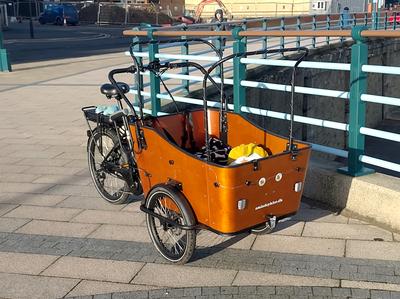
I'm not used to writing reviews and I don't have any financial incentive to do it, so this is quite a rambly collection of thoughts about the bike.
Why I want a cargo bike
I live in Whitley Bay, in the north-east of England, with my wife and two kids. I work mostly from home, but commute on the Metro to the university in Newcastle. Whitley Bay isn't the Peak District, but it's by no means flat; we live a few minutes up a moderately steep hill from the beach. There are plenty of safe bike routes round here, but not much dedicated infrastructure. I largely get around on short trips by using quieter streets. There are a couple of routes into Newcastle or along the river which have dedicated bike lanes almost all of the way.
I already use my standard bike regularly for small trips to the shops, nearby family, and just for exercise. My wife and I both have Hamax child seats on the backs of our bikes, which we had been using to take the kids to nursery/school, playgrounds, or to visit our mothers who both live within 10 minutes of us.
I'm disabled: among other things, I have vasovagal syncope tendency, which means I get tried very quickly when standing still, or walking slowly. Within a few minutes my blood pressure drops and I get very wobbly. It takes me a long time to recover from this.
However, I can easily ride a bike for a long time, so I use it as a mobility aid.
While the kids' school and nursery are only a 15-20 minute walk away, walking there and back was leaving me tired for the rest of the day. I had been cycling to school with my eldest either on the back of my bike, or riding her own bike or scooter. But towards the end of the last school year, she started to refuse to do that, and she's growing too big for the seat anyway. We're both autistic, and I just don't have it in me to have an argument about how we get to school, and then tire myself out walking and potentially carrying her scooter or bike as well.
With the youngest starting nursery in September, we needed a way of getting everyone to school and back.
We'd seen Babboe cargo bikes in the Netherlands on holiday, so started looking into whether it would make sense to get a cargo bike.
Over time we met a handful of other people with cargo bikes, so always tried to ask them what they thought about them. They were unanimously positive; it became a bit of a joke between us that cargo bike owners were almost evangelical: they'd sing the praises of their bikes and give us plenty of time to ask questions. One man even offered to let us borrow his bike!
It seems that cargo bikes are in the same category as air fryers of products that make you say to everyone you meet, "you've got to get one! It changed my life!"
So over the Summer we decided that a cargo bike would a be a good idea. We had two cars: a Ford C-Max for everyone, and a Hyundai i20 that my wife used to commute to work. Our thinking was that it didn't make sense to waste petrol driving a heavy car with two child seats, but after a year of using the i20 it didn't work out any cheaper with tax and insurance. So we sold the i20, leaving us plenty of money to buy a cargo bike.
Shopping around
There's a shop in Tynemouth called Ride Electric that sells only Riese & Muller bikes; those start at about £5,000 and go up to £9,000. They offer a free "cargo bike experience" (a.k.a. a test ride). I went in to book one, but they asked me to sign a waiver of all liability on their part, even if something happens due to their own negligence. No thanks!
Our holiday last Summer was in the Netherlands, and I realised it would be a good opportunity to hire a cargo bike for a few days. We hired a Babboe City Mountain from Geerts Tweewielers in Otterlo.
We used it every day, using it for pretty much all of our travel, except for the day we drove into Arnhem, which would have taken a couple of hours on the bikes. It was so convenient being able to arrive somewhere and leave the bike very close to the destination, instead of hunting for parking and then walking.
Skipping past the huge queue for the car park and leaving the bike right outside the gates of Julianatoren was very satisfying!
The Babboe Curve is a two-wheeler with a mid-motor. We loved it, and so did the kids.
The eldest complained that it was too loud inside the bucket: she's autistic, and found the noise very difficult to ignore.
Stopping is awkward: you have to heft it back onto the feet.
The City Mountain was very nice, but outside our price range.
Once back at home, I tried to find a nearby shop that would have some cheaper cargo bikes in stock to try out.
The closest shop I found was Get Cycling CIC in York. They specialise in "inclusive cycles", which pleased me since I mainly use my bike as a mobility aid due to my disability.
The staff at Get Cycling were very friendly, but a bit useless. I couldn't make an appointment for a test ride, they just told me to come down and see what was there on the day. Once I was there, they were very generous: they let me try both a Babboe Curve and an Aitour bike and gave me a map of some recommended routes, and basically left me to it. I was expecting to have to sign some forms or leave a deposit or something!
My mental image of Yorkshire is rolling hills, but it turns out that York City is very flat. The steepest hill I found was outside the Terry's chocolate factory, but it wasn't much compared to the hills at home.
I got about 10 minutes away from the shop when the bike's display said something about low voltage, and then it switched off. I had to pedal the bike back under my own steam, which was hard work! At least it reassured me that when the motor stops working, you're not completely stuck.
When I finally got back, something had arrived on a lorry so all the staff were out helping to unload it, and I couldn't really get anyone's attention. I asked about how to order a bike, and they said to email the boss.
I left York without putting in an order, and decided to look online.
It was unclear who had any bikes in stock and what lead times would be. At this point it was early August, and we needed to have a bike in time for school at the start of September.
e-bikesdirect looked the most reliable of the bunch, with a big range of stock, so I asked them if they could get a bike to me before the end of the month. The person I spoke to was really helpful, and guaranteed that they could deliver a fully-assembled Ultimate Harmony bike within the fortnight, before the end of August.
They were true to their word, and the bike arrived with a week and a bit to spare, ready to ride.
Actually reviewing the actual bike
Short story: I really like it.
The kids love it too, and immediately started calling it "the bucket bike".
The bucket is a lovely bit of curved wood, with bench seats at either end providing space for four kids or two adults (we've tested both those possibilities). We've had the kids and their two cousins in, and everyone was comfy.
There's no door on the bucket, so the kids either have to climb in or I have to lift them in. The eldest could climb in on her own from the start; my youngest who's now 108cm tall has just started climbing in on his own too.
The bucket is very big; I think it's the biggest I've seen on any cargo bike. There's loads of space for the kids and all their stuff. It's not unusual for us to go down to the seafront with two kids, both their bikes and/or scooters, a full backpack, a towel and the bag of emergency supplies all at once, with room to spare.
Being able to carry the kids' bikes opens up lots of opportunities: they can ride for a bit, then get in the bucket when they're tired. It's a bit awkward fitting my eldest's 14" bike in when we have the rain cover on, but it is possible. With the rain cover off, it's really simple to just chuck stuff in, and leave a wheel or handlebar hanging over the edge if necessary.
The handlebar is more like a pram's than a normal bikes: it's a long U-shaped bit of metal that attaches to either side of the bucket, with brake levers and the gear changer in the middle. It took quite a bit of getting used to, but I quite like it now: it's good to put your hand out on the edge when making a sharp turn, and closer to the middle when going straight.
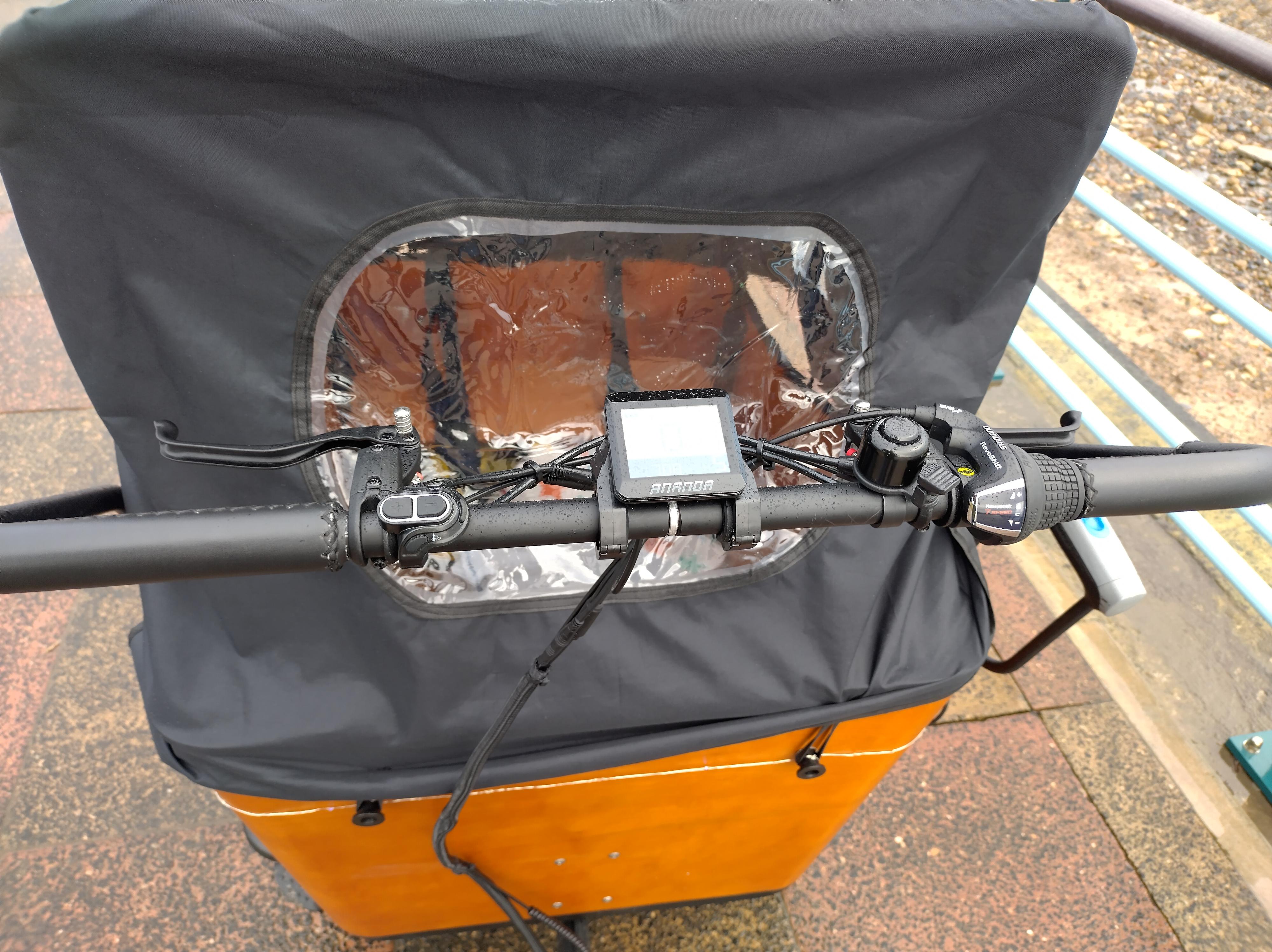
The handlebar is like a pram's.
Because there's no central tube for the handlebars, there's bags of leg room. That suits me and my very long legs!
The rain cover is a bit of tough waterproof fabric with windows on each side. Two big U-shaped poles attach to the bucket, and the rain cover sits on top of that. It's pretty easy to put on and take off, though it's only held on by loops of stretchy cord which take quite a bit of strain. Two of the loops must not have been sewn on properly because they snapped off very quickly, one of them the first time we used the cover. A friend with a sewing machine reattached them, and we haven't had any trouble since.

I was worried about my view of the front when the rain cover is on. Even though it felt quite tall when I first put it on, in fact I hardly notice a difference when riding.
When we got the bike in the Summer I didn't put the roof supports on, but they've stayed on since it started raining. Even with the rain cover off, they don't get in the way, and I suppose they make the bike look a bit bigger, which is reassuring when amongst traffic.
The rain cover is easy to fold up. I put it under the seats so I can get it out quickly if it starts raining.
I was surprised to discover that the rain cover is hydrophobic: rain drops skitter about on top of it, rather than being absorbed. When it's raining heavily a fairly big puddle can form on top, which can splash up at me if I hit a bump, or fall on the kids' heads as they're getting out if I forget to clear it first.
We wanted to get the official seat cushions for the kids to sit on, but e-bikesdirect have never got back to us saying they're in stock, so I've put a folded up fleece throw down instead, which seems to do the job.

It's nice and comfy inside the bucket with the rain cover on.
I was worried that they'd get cold in the winter, but with the rain cover on it quickly gets quite toasty inside and they've never complained. On sunny days with the rain cover off, I put another blanket over their legs and they seem happy enough. When we first got the bike it was still hot, and everyone was happy with bare legs and arms.
It's been a mild winter this year, but we've had plenty of difficult weather. I really appreciated the motor during the storms. When it really chucks it down I have to put waterproofs on, but otherwise it's a surprisingly comfortable ride whatever the weather. I mean, less comfortable than sitting in a car, but it's never been so bad that I've avoided riding the bike.
Gloves are a must: my body just stops heating my extremities when it gets a little bit cold, so the wind chill freezes my fingers very easily.
The motor is controlled by a little set of buttons on the handlebar. There's a button to turn it on or off, buttons to increase or decrease the assist level, one to toggle the rear light, and a "walk assist button". The buttons aren't great quality: they're made of pretty spongey rubber and you have to press them in just the right way to activate them.
The walk assist is only on the top range of Babboe bikes, but I suppose it's easy enough to implement. It's for when you're on foot and pushing the bike. When you hold the button down, the motor provides a little bit of force which can help you get the bike moving if it's heavily laden. I've only used it a couple of times, once when I had a lot of stuff in the bucket and needed to get the bike over a kerb, and the other when my daughter wanted to walk alongside me and I had all her stuff in the bucket.
The display shows the current speed, the motor assist level, and the amount of charge in the battery. The battery display is split into five pips, which is somehow more precision than it can actually offer: I've seen it vacillate between 1 pip and 4 pips several times during a ride. I think that the estimate is quite sensitive to the temperature and to how quickly the battery is draining. It seems least accurate when I'm on the highest assist mode, and quite stable on level 3 or below. The net result is that when it goes down to one pip I stick to the lower assist modes, but I haven't managed to completely run it to empty yet.
There's a pretty weedy ping bell on the handlebar, which isn't enough given how quickly I can approach people on a hill. I'm not an aggressive cyclist and I rarely ring my bell to ask people to get out of the way but I feel I should let people know that an unusually big bike is about to pass them. Fortunately, when the kids are in the bucket they can provide their own warning sounds!
There's no suspension on the wheels, so the ride is quite bumpy, especially for the kids in the bucket. Any hard things in the bucket make quite a clatter as you roll over bumps. The road surfaces round here aren't particularly smooth, so people definitely hear me coming!
Riding a three-wheeler is very different to a two-wheeler, particularly on corners: you don't get the benefit of the gyroscopic effect, so you have to take corners much more slowly. I learned that leaning in to a turn really helps to keep the centre of gravity where it should be; since learning that, I've been much more comfortable. It feels like a really exaggerated motion at first.
The bike has a light on the back, built into the battery housing. It works as a brake light and also as a rear light, which seems to turn on automatically when it's dark. I can force it to turn on with a long press of the headlights button on the motor controls.
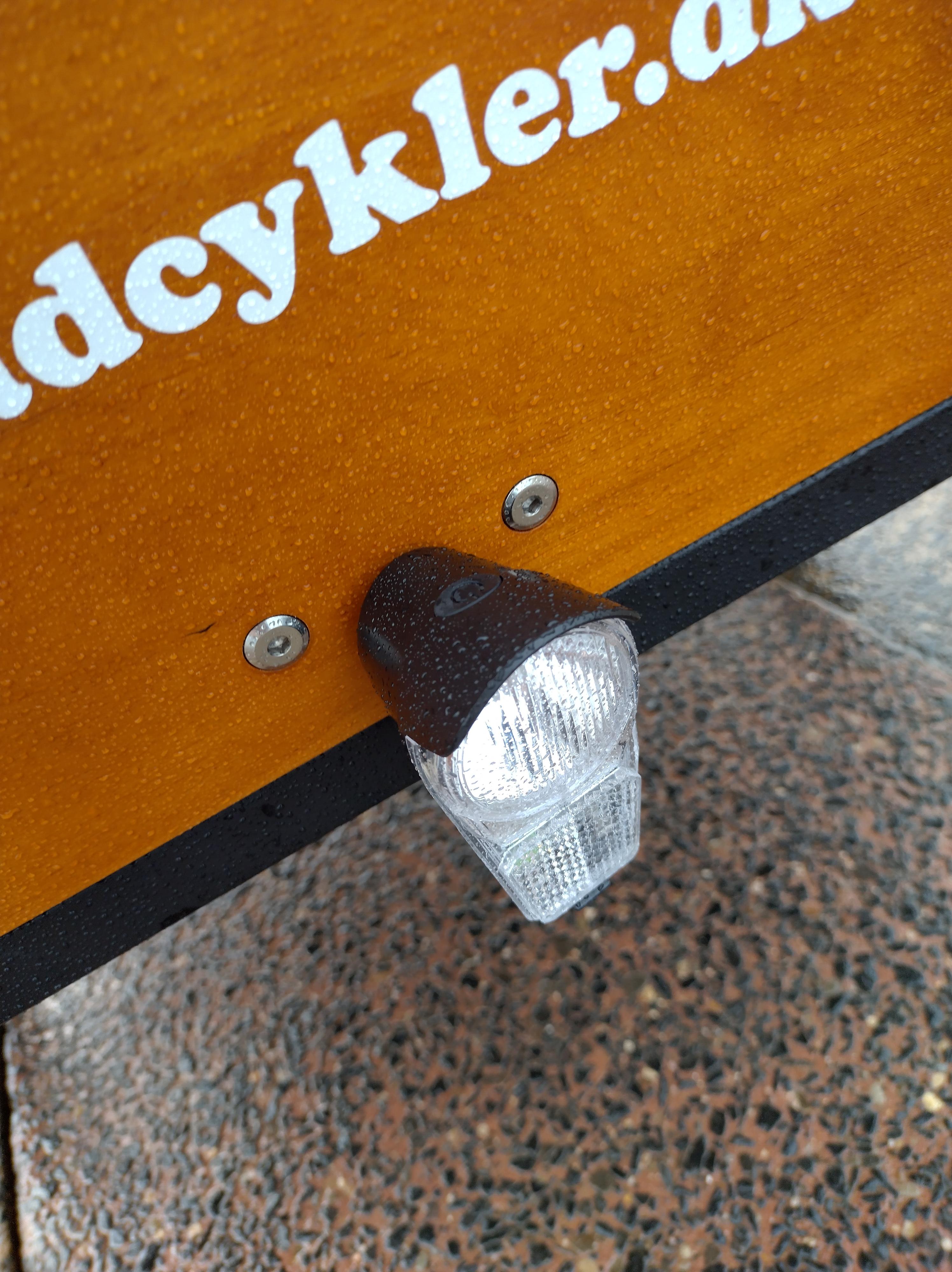
The front light isn't great.
The front light is very disappointing: it's not connected to the main battery, so it's powered by two AAs which are annoying to continually replace. It doesn't feel like it's powerful enough to be really safe at dusk. I've tried searching for a better light to replace it with, but every other bike headlight I've found is designed to attach to a handlebar tube.
Because the light is so low down, I can't tell if it's turned on when I'm sat behind the bucket. Ideally I'd be able to control it with the headlights button on the handlebar, and the display would tell me if it's turned on.
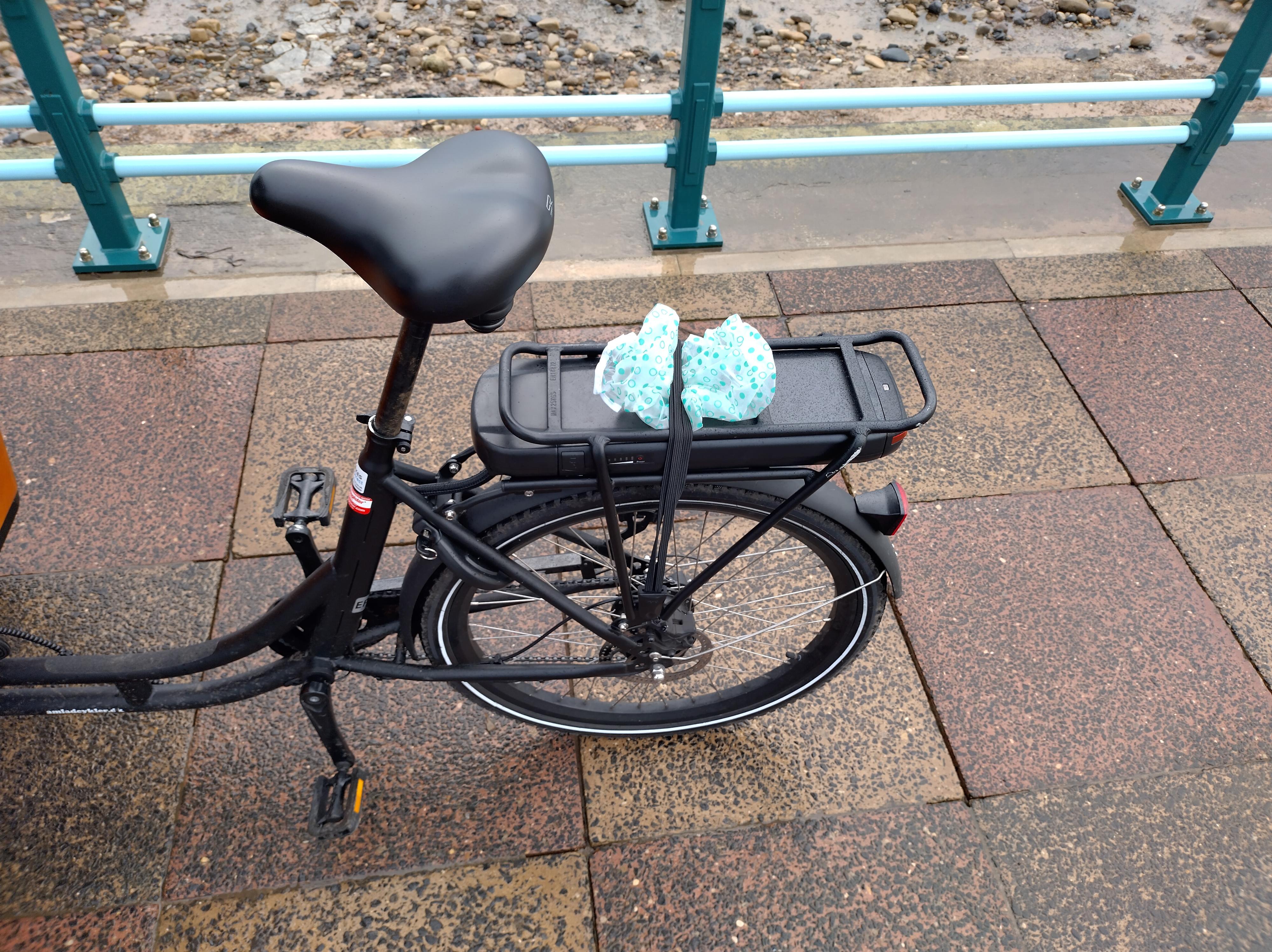
The seat is very comfortable to me, but my wife has complained it gives her a sore bum after a while. We've made a note to look into sit-bone measurements.
There's a quick release lever to easily adjust the height without a spanner. It's a bit fiddly: there's a thumb screw which is very sensitive to movement, and because I have the seat nearly as high as it'll go and she has it nearly at the bottom, we have to adjust it each time we swap.
With the Babboe, I get pretty bad shoulder and back pain each time I rode it for more than 45 minutes or so. I think that I was having to put a lot of effort into keeping it upright, and I was sitting too straight; when I hunched back like a Harley Davidson rider it was more comfortable.
I haven't had any trouble with the bucket bike. Because it's a three-wheeler, it can't fall over, and I haven't noticed any strain in my back or shoulders.
There's a pannier rack over the back wheel which came with some bungee straps. If we had too much stuff to even fit in the bucket I suppose we could strap it on there. At the moment, it's just holding the shower cap I bought to keep the seat dry when I've parked it outside in the rain.
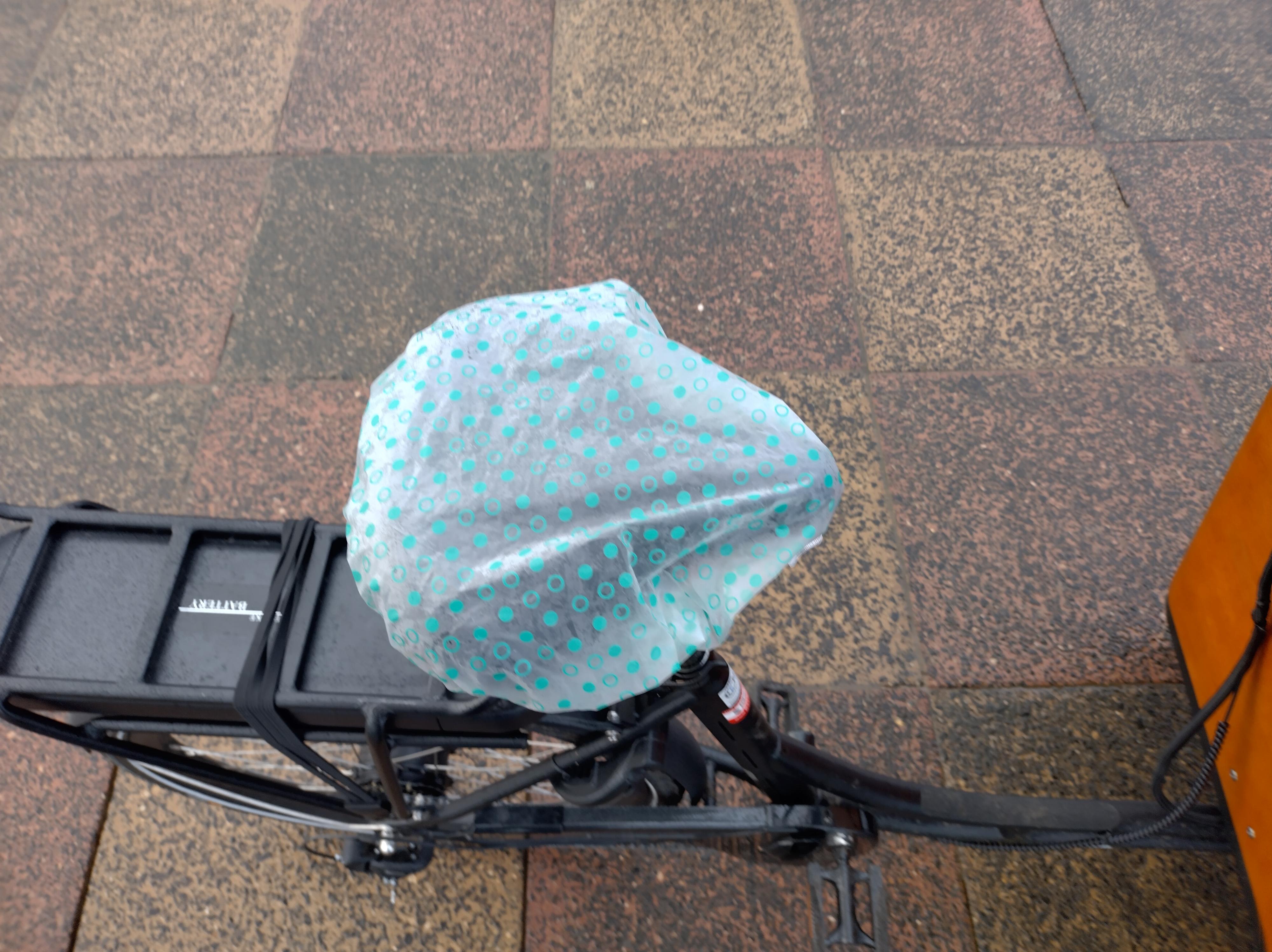
Keeping the seat dry is a small act of self-care.
I'm aware that a cargo bike is an unusual sight here, so I felt very self-conscious at first. I was also unsure about exactly where the cargo bike fits in the road hierarchy: it's bigger than a standard bike, but much smaller than even the smallest car. Since we don't have dedicated bike lanes round here, I'll occasionally have to ride my standard bike on the pavement for a few metres in order to get to a cut. It doesn't feel right to do that with the bucket bike, so I go out on the road more often.
After a few weeks I got used to people staring at the bike or commenting on it, and I feel like I've got a good idea of where it fits. For what it's worth, the comments I've heard have been universally positive.
In Whitley Bay there aren't many modal filters, but on trips further out I've had a couple of unhappy times when I encountered a barrier designed for a normal bike to fit through, but which the bucket was too wide for. This is an access issue: they block all sorts of other mobility aids such as mobility scooters, so I think some activism is needed to replace them with something more equitable.
My friend gave me a couple of stickers, which I put on the front of the bucket. Together with the amladcykler logo, from a distance it looks a bit like a face, which I enjoy.
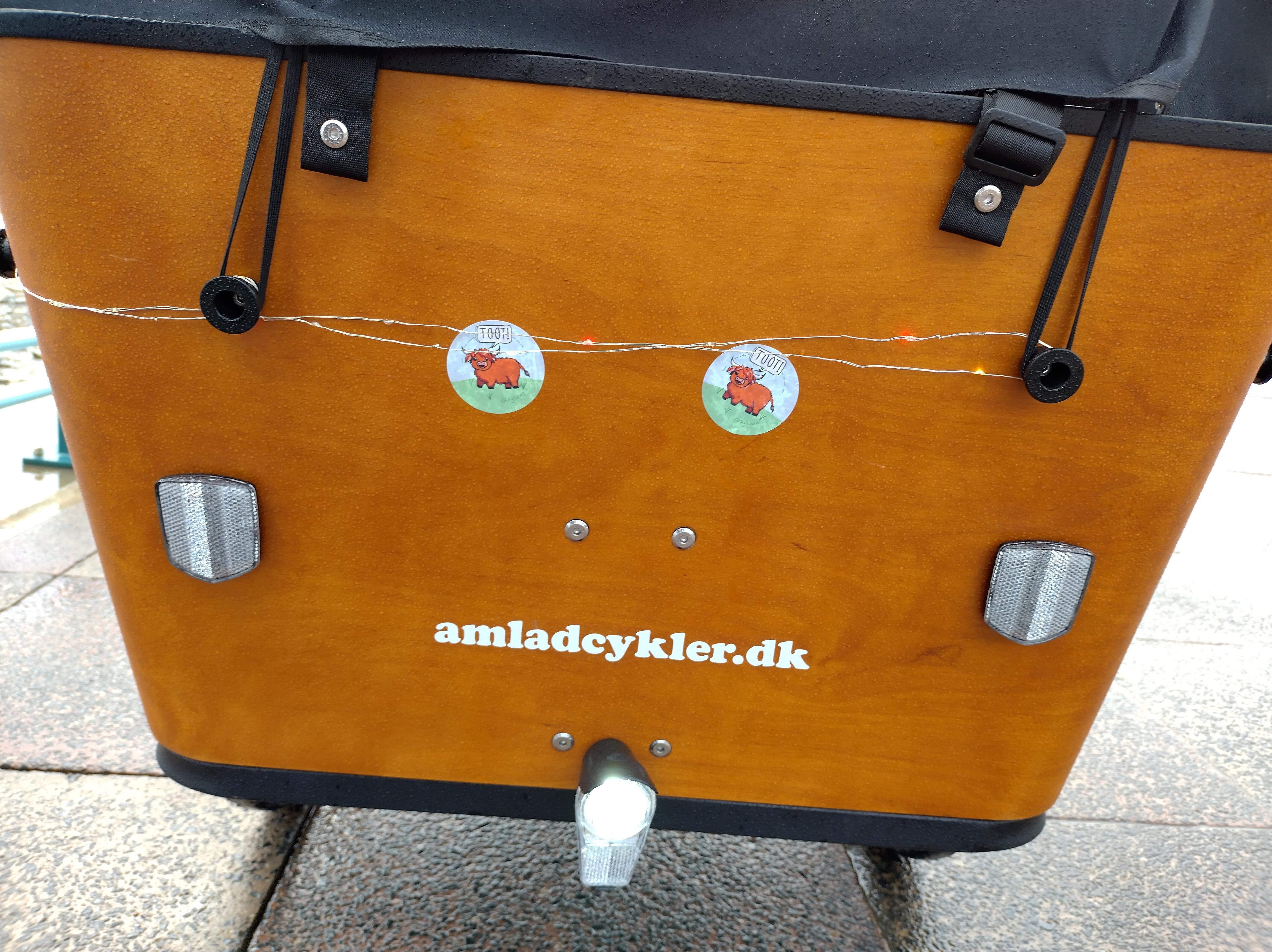
Toot! Toot!
As the days got shorter, I worried about visibility. In order to make the bike more visible, and to bring some seasonal cheer, I bought a set of outdoor battery-powered LEDs and wound them around the bucket and the roof supports. The three-year-old loves turning them on, and nobody can miss us. Someone on Mastodon pointed out that you need to be careful not to have any front-facing red lights. I don't think that the mix of lights is confusing to anyone, since they're so much weaker than the main headlight.
I keep a bag for life with some "emergency supplies" under the front seats. It's got a towel, some spare clothes for the kids, long-life snacks, a multitool for the bike, and usually whatever toys the kids were playing with last. It's so convenient to just have everything I need without any planning!
Basic questions about cargo e-bikes
We had a lot of questions about cargo bikes, some of them really basic. It was hard to find answers to all of these online, so I've tried to list as many as I can here in case anyone else is wondering.
Does it have to be electric?
Yes.
I'd never ridden an e-bike before, and I'd seen non-electric Bakfiets bikes around. Electric cargo bikes are significantly more expensive than non-electric ones.
I just don't think it's worth not having a motor. It helps you go so much more easily, and to carry much more stuff.
Security - is it safe to leave?
My standard bike was a couple of hundred quid. I've had one stolen from the Metro station, which was very annoying but not a huge hit to our finances. Cargo bikes are several thousand pounds. We couldn't afford for it to be stolen. So how can I keep it safe?
I don't know if I've overthought this. At least, our bike hasn't been stolen yet.
The bike we rented in the Netherlands just had a frame lock. These aren't very common in the UK. It's just a metal hoop which fits on to the fork around the back wheel. When you lock it, the hoop goes through the wheel, stopping it from turning. When you unlock it, the half going through the wheel retracts. The key stays in the lock while it's open, meaning you can't lose it. It's a really good basic system, but doesn't protect against someone just picking the bike up. I suppose with a heavy cargo bike that's not easy to do.
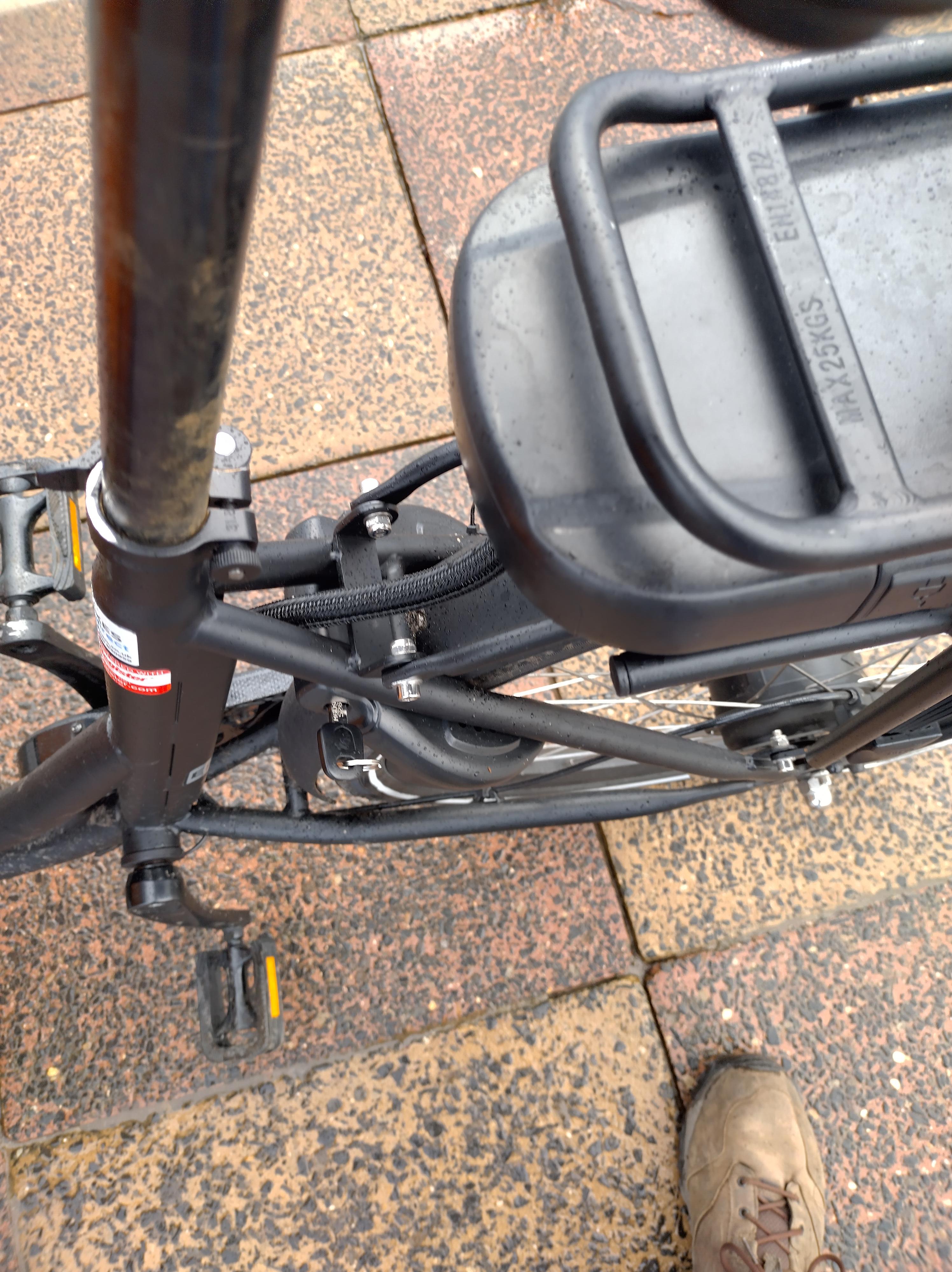
The frame lock is so convenient!
Our bike was supposed to have a frame lock already fitted, but arrived without it. After several annoying months of phonecalls to e-bikesdirect, who were always pleasant but seem not to be able to actually put a frame lock in the post, I ordered one from bikeINN, which I think is based in Spain. I couldn't find a measurement for either the lock or the bike frame to match up, so ordered what I thought was the same AXA model that amladcykler sell on their website. In the end, the lock I bought was a couple of millimetres too wide for our bike's frame, so I had to just put one screw in and use a cable tie to hold the other end. The mounting doesn't affect the security, anyway: that's provided by the hoop going through the wheel.
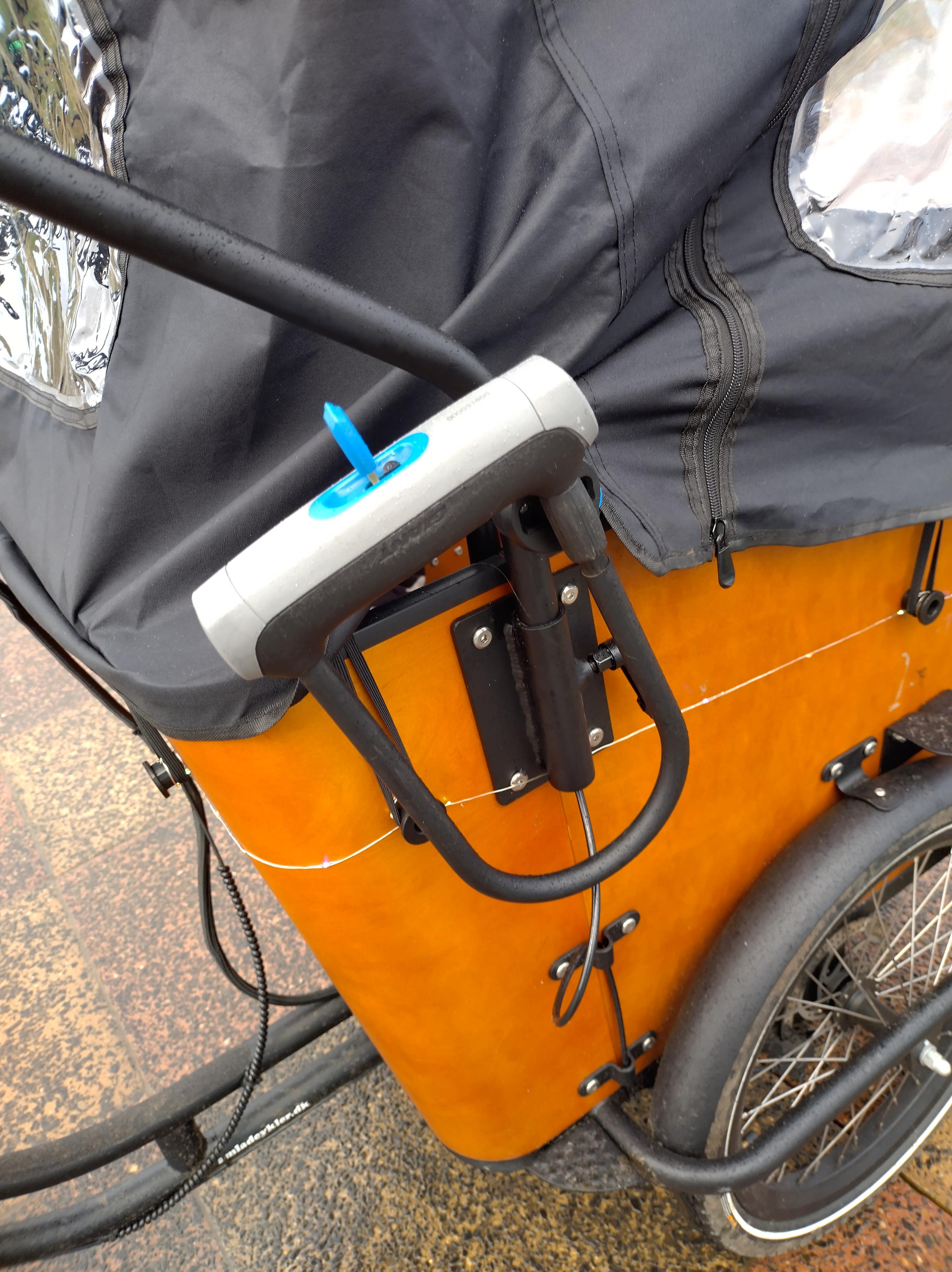
While we were waiting for the frame lock, I used the Giant D-lock that I already have. It has a holder which I screwed on to the side of the handlebar, so it's only slightly less convenient than the frame lock. Now we keep both on the bike; I'll use the frame lock when I'm only away from the bike for a few minutes because it's so convenient, but put the D-Lock on as well if I'm leaving it for longer.
When the bike arrived, I registered it with bikeregister, using one of their kits that marks the frame with a code linked to their database. It occurred to me that this is either positive or negative, based on the security of the bikeregister database: if a baddy who wants a particular model of bike has access to the database, they can just look up the addresses of people who own one. But I don't think that's worth fretting about, compared to most bike theft which is opportunistic.
Anyway, it didn't cost much compared to the total cost of the bike, so I thought I might as well do it.
I'd heard of people sticking Apple AirTags on their bikes, so they can track their location in the event they're stolen. There are some other makes of tracking tag designed specifically for bikes, but I think that the big benefit of AirTags is that there are millions of phones that will detect them automatically and report their location. I've stuck the AirTag in what I think is a non-obvious place. Thieves might well know to look for them now, but hopefully they wouldn't do that at the place they steal the bike from, so there'd at least be some chance to see which way it went. Again, it wasn't expensive, so I thought it was better to have than not.
This leads on to...
Can I get insurance?
While trying to find a company that would insure the bike in case of theft or damage, I realised that some people spend a lot more money on bikes than I ever imagined! I paid £86.80 for a year's insurance from PingInsure. That felt like more than I was expecting to pay; I suppose I'll look around for cheaper quotes when it's up for renewal.
How big a motor do I need?
🤷
There are loads of kinds of e-bike motors, and I have no idea how the stats work. amcargobikes say that the Ultimate Harmony has a "250W Brushless engine", which matches the other bikes I tried. It's plenty. I can get up a steep hill with two kids and all their clobber with no trouble, at a decent lick.
When we hired the Babboe, I asked the guy about motors. He said that Bosch are the best, but didn't really have anything else to say.
Would it be too fast?
The motor is limited to 25 km/h - it stops pushing when you get that fast, but doesn't brake. So going downhill, I've reached about 28 km/h, just from gravity.
Most of the time, going about 18 km/h feels comfortable; that seems to be where the middle motor assist mode wants to be. We don't have a speedo on any other bike, but when my wife is riding the bucket bike, we ride together comfortably.
I've recorded long rides into Newcastle both on the bucket bike and my normal bike with the OpenTracks app; both were about the same average speed.
What's the right price to pay?
We set out thinking that our speed would be about £2,000. In the end we paid £3,419 for the bike, fully assembled and delivered, a bit more than we were hoping for. We paid a little bit over the odds because we were in a hurry to have it ready for the start of school.
There's a shop in Tynemouth called Ride Electric that sells only Riese & Muller bikes; those start at about £5,000 and go up to £9,000. Well outside our price range!
Babboe bikes, when they were on sale, were on the higher end, starting at £3,500; I think the model we wanted was about £4,500.
The Ultimate Harmony was suspiciously cheap: it was about £1,000 cheaper than the Babboe Curve, which I think is the closest equivalent. I wasn't sure if it would turn out that they'd cut corners in the build quality, or if the difference is just down to it being a less well-known brand. So far, it fortunately seems to be the latter!
Mid motor or rear motor?
It took me physically looking at an e-bike to understand this!
An e-bike can either have the electric motor where the pedals are (mid-motor), or where the wheel is (rear-motor).
The received wisdom seems to be that mid-motor is best. I think this might be because your pedalling is directly controlling the motor.
With a rear motor, when you pedal it triggers the motor to start working. The motor keeps working for a few seconds after you stop pedalling, or until you use the brakes. That took a little bit of getting used to - I'd stop pedalling, expecting to glide to a stop, but the motor would keep pushing me forwards.
I wasn't clear on exactly how the pedals and the rear motor interact. It turns out that they work independently to push the wheel: when I pedal, the chain moves that force to the wheel; simultaneously, the motor attached to the wheel is also pushing.
I expect I'll understand it better after something breaks!
So I was hoping to get a mid-motor, but I have no complaints about the rear-motor I've got.
Battery capacity?
My gut feeling was that I'd want as much battery capacity as possible.
The amcargobikes website says that the battery is "36V, 13 Ah Li-ion battery – 468WH". I read somewhere that it would comfortably do about 40km on a single charge, and my experience is that that is correct: I rode in to Newcastle and back, a trip of pretty much exactly 40 km, with the motor assist set between 3 (the middle) and 5 (the most), and the battery meter was blinking to say it was low when I got back.
I've been plugging the bike in roughly once a week. It takes a few hours to charge up to full from almost-empty.
Using the higher motor assist mode seems to drain the battery much more quickly than level 3: there's probably a square law in there somewhere. I use level 3 pretty much all the time, going up to 4 or 5 for a steep hill or when I'm in traffic and feel I shouldn't slow the cars down too much.
What if the battery runs out?
I think this was one of the biggest questions I had before trying an e-bike. If the battery runs out or stops working, am I stuck?
Mitch Hedberg said an escalator can never break - it can only become stairs.
If the motor on the bike stops working, I can still move it with the pedals.
Charging - fire risk?
I've heard lots of scary stories about low-quality batteries catching fire while charging. I don't really know where the battery in our bike came from, so in my head it's still in the "potentially dangerous" category, though I don't know what I would need to see to be confident it's a good one.
It hasn't caught fire yet!
So we've tried to set some reasonable rules: I try to only charge it when I'm in the house, during the day.
I bought a Firechief dry powder fire extinguisher which I've mounted to the wall in the garage near where we charge the bike. It took me a long time to work out what class of extinguisher is appropriate for a battery fire. The one I got says it's good for class A, B and C fires. One of those covers battery fires; I've forgotten which.
I also put an optical smoke alarm above where we charge the bike.
I asked at work if they have any rules about where people can charge e-bike batteries. There doesn't seem to be a policy yet, but apparently someone is looking into it.
What makes are there?
We'd seen a couple of Bakfiets and Babboe bikes, as well as the expensive Riese & Muller bikes that Ride Electric sell (or at least they stock them; I haven't seen anyone apart from the owner actually riding one yet!)
While tyrying to find a bike we could actually get hold of, I discovered Aitour, which seemed perfectly acceptable. I couldn't get hold of one though, but e-bikesdirect said they did have amcargobikes in stock. And they looked really good!
Do I need a well-known brand?
A cargo bike is very expensive and the market is just taking off, so I would have preferred to play it safe with a popular brand, on the assumption that the buidl quality would be more reliable and I'd get better support.
Well, just last week Babboe have had to recall all their bikes because the quality of their frames isn't good enough, so I'm glad I didn't pay the premium for that!
I'm really pleased with the bike I've got from amcargobikes. The build quality is very good, and the curved wooden bucket is really nice to look at.
They could do with a bit more work on branding: it arrived with just a couple of sheets of A4 giving legally required information and not much else. There are assembly instructions on their website which I'll refer to when it's time to fix something, but apart from that I feel like I don't know much about my bike!
The Babboe that we rented had a nicely-designed manual in a paper booklet, with answers to a few of the basic questions we had.
Three or two wheels?
Two-wheeler and three-wheeler cargo bikes give very different riding experiences.
They both have pros and cons.
A two-wheeler handles pretty much like a normal bike. The Babboe we tried was a two-wheeler, and some engineering arrangement meant that turning the handlebars would turn the small wheel in front of the bucket. Gyroscopic force (or whatever it is) keeps the bike vertical while it's moving, and importantly while it's turning. But when you stop you have to put your feet on the ground, or put the kickstand down. The two-wheeler we tried had a beasty two-legged kickstand which took a lot of heft to get down.
A three-wheeler stays up when it's not moving, at the cost of being quite unstable when it's moving at speed. The first time I took our three-wheeler out, I didn't realise just how unstable it would be on corners, and lost control. Fortunately the kids were strapped in and just bumped into each other without any injuries, but they certainly didn't enjoy it!
The steering feels very, very loose: you have to keep two hands on the handlebar when you're going at anything more than 12 km/h, or you can easily lose control.
I rang e-bikesdirect to ask if there was anything I could do to dampen the steering, but they said it just takes some getting used to. That's mostly true: I've got much more used to riding it, and feel secure now, but I'd like to be able to take corners a bit faster. It's also annoying when you're going at full pelt and need to take a hand off to scratch an itch. I haven't dared try that yet!
Maintenance?
There are lots of bits on the bucket bike that I'm not used to: the whole electric motor system and the disk brakes are the bits I was most concerned about.
They recommend that you take the bike to a mechanic for a service six weeks after getting it. We haven't done that, but it seems fine.
I've had to fiddle with the gear cable twice as it stretched with use, but I'm happy to do that myself.
We've had the bike for almost six months now and there doesn't seem to be any noticeable wear on anything else.
The battery seems not to have lost a noticeable amount of capacity.
Import?
The hardest part of getting hold of a cargo bike was Brexit: all the brands I looked at are made in the EU, so now they're a hassle to import, with import duty to pay.
I didn't want the hassle of arranging that myself, so I was happy that e-bikesdirect already had a bike in their Sussex warehouse and could just sell it to me.
Hills?
We loved using the cargo bike in the Netherlands, but there aren't any hills there. (We stayed near "the highest waterfall in the Netherlands", and fell over laughing when we saw it: I could almost see over the top of it when stood at the bottom!)
It's not enormously hilly here, but there are some steep bits that I need my lower gears for on my standard bike. I was quite anxious that if the cargo bike's motor wasn't powerful enough, we'd have to plan routes around that.
The steepest slope we regularly use is from the prom up to Spanish City. With the motor assist at its highest and in a low gear, I can get the fully-loaded bucket bike up it without really exerting myself.
So no worries there!
Conclusion
I've become one of the cargo bike nutters we used to joke about: you should get one! It's great! It changed my life! No regrets!
I hope this is useful to someone. If you have any comments or questions about this, you can contact me on @christianp@mathstodon.xyz or christian@lawson-perfect.uk.